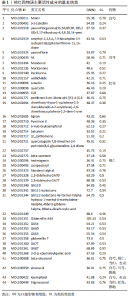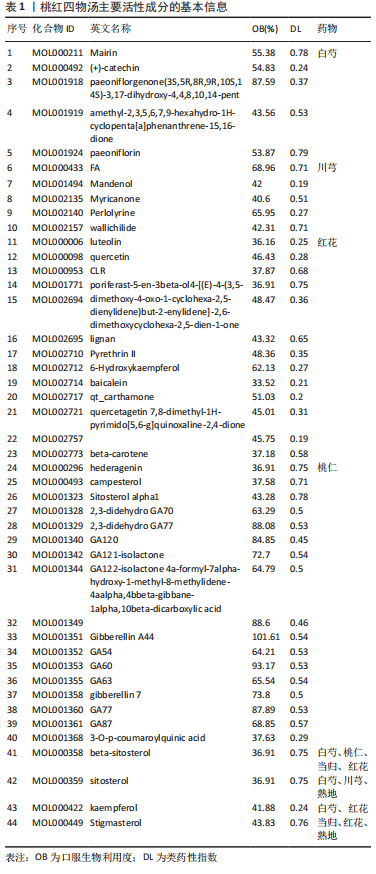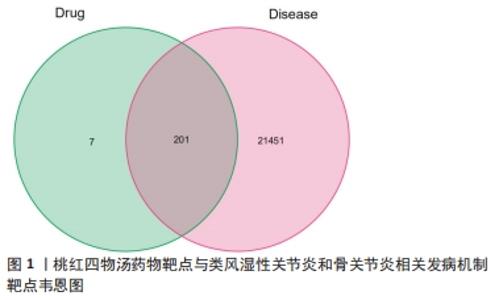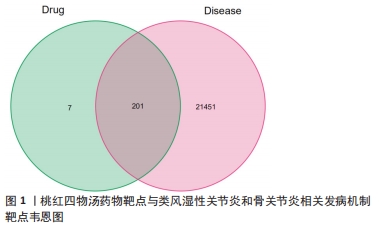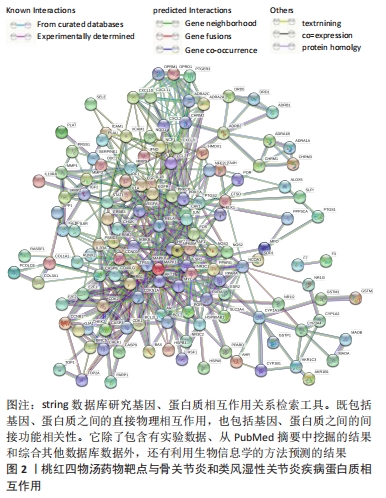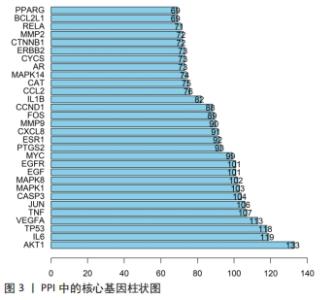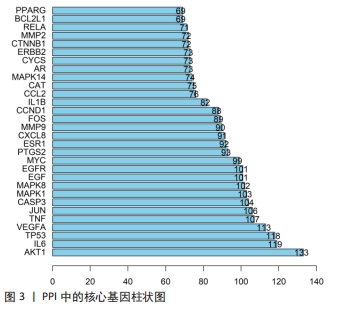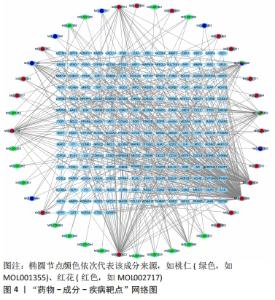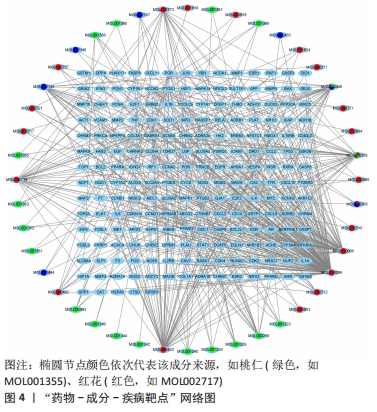Chinese Journal of Tissue Engineering Research ›› 2022, Vol. 26 ›› Issue (15): 2419-2425.doi: 10.12307/2022.601
Previous Articles Next Articles
Network pharmacology and molecular docking analysis on Taohong Siwu Decoction for rheumatoid arthritis and osteoarthritis based on the concept of “Treating Different Diseases with the Same Therapeutic Principle”
Wang Xinyuan1, Huang Xiabing2, Li Juan2, Deng Xin1
- 1Guangxi University of Traditional Chinese Medicine, Nanning 530012, Guangxi Zhuang Autonomous Region, China; 2First Affiliated Hospital of Guangxi University of Traditional Chinese Medicine, Nanning 530012, Guangxi Zhuang Autonomous Region, China
-
Received:2021-09-01Revised:2021-10-30Accepted:2021-11-20Online:2022-05-28Published:2022-01-06 -
Contact:Huang Xiabing, Master, Associate chief physician, First Affiliated Hospital of Guangxi University of Traditional Chinese Medicine, Nanning 530012, Guangxi Zhuang Autonomous Region, China -
About author:Wang Xinyuan, Master, Lecturer, Guangxi University of Traditional Chinese Medicine, Nanning 530012, Guangxi Zhuang Autonomous Region, China -
Supported by:Guangxi Autonomous Region Education Department Project, No. 2020KY07031 (to WXY)
CLC Number:
Cite this article
Wang Xinyuan, Huang Xiabing, Li Juan, Deng Xin. Network pharmacology and molecular docking analysis on Taohong Siwu Decoction for rheumatoid arthritis and osteoarthritis based on the concept of “Treating Different Diseases with the Same Therapeutic Principle”[J]. Chinese Journal of Tissue Engineering Research, 2022, 26(15): 2419-2425.
share this article
Add to citation manager EndNote|Reference Manager|ProCite|BibTeX|RefWorks
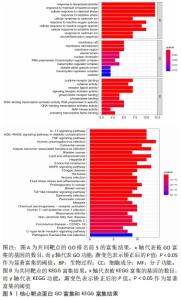
2.5 GO功能富集分析和KEGG信号通路富集分析结果 为了探究药物与疾病的共同靶点的功能,通过R在线工具进行了富集分析。结果显示在GO功能富集中,生物过程(BP)中,主要参与对氧化应激的反应、细胞对化学应激的反应、对活性氧的反应、对金属离子的反应对脂多糖的反应。在细胞成分(CC)中主要富集于转录调节复合体、质膜筏、小窝、膜区、膜微区、膜筏。在分子功能(MF)中主要与泛素样蛋白连接酶结合、DNA结合转录因子结合、RNA聚合酶Ⅱ-特异性DNA-结合转录因子结合、类固醇激素受体活性、配体激活的转录因子活性的活动有关。此外,在KEGG通路富集结果中,骨关节炎与类风湿性关节炎与IL17信号通路、TNF信号通路、MAPK信号通路、PT53信号通路等密切相关,见图5。"
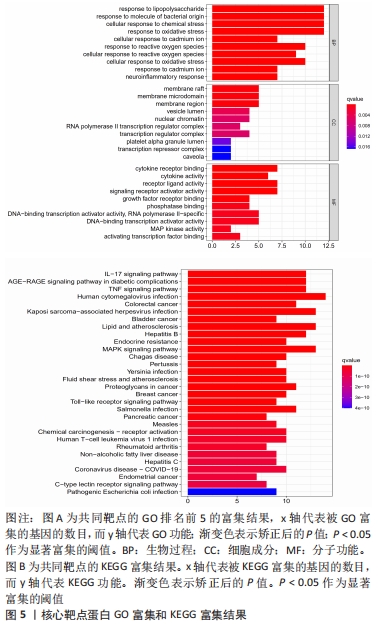
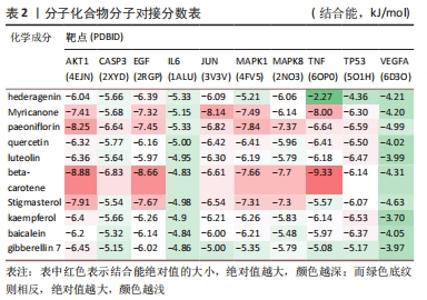
2.6 分子对接结果 将2.5筛选到的核心靶点与主要的化学成分采用分子操作平台软件MOE (molecule operating environment)进行对接验证,更能直观展示关键成分的最佳构型和核心靶点之间的相互作用,分子与标靶蛋白的最低结合能均小于0,说明配体与受体均可以自发结合。Hsin KY就分子对接的研究而言,结合能(kJ/mol)越小,表明活性物质与蛋白质之间对接的结果就会越牢固。当结合能的数值小于-4.25 kJ/mol时,则表示活性物质与蛋白质之间有一定结合活性,小于-5.0 kJ/mol时有较好的结合活性,小于-7.0 kJ/mol时有强烈的结合活性[18]。用MOE中的Dock模块进行分子对接,选择基于蛋白和配体间相互作用能的打分函数ASE,分别得到每个化合物与受体的对接打分,打分越低,配体与受体结合越稳定,结果见表2。"
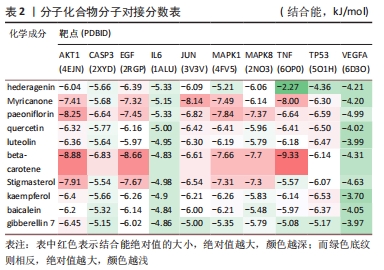
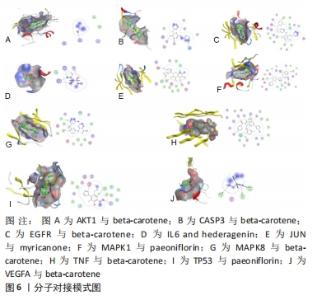
总体来说,AKT1、EGF、JUN、TNF、MAPK1、MAPK8、TP53与化合物结合相对稳定,其中AKT1、EGF、TNF、MAPK8与beta-carotene的结合能分别是-8.88,-8.66,-9.33,-7.70 kJ/mol,JUN与Myricanone结合能是-8.14 kJ/mol,MAPK1与paeoniflorin的结合能是-7.84 kJ/mol。主要活性成分和核心靶点之间的结合情况与预测关系相符。将结合将为稳定的化学成分与靶点进行对接可视化,见图6。如图6A,AKT1与beta-carotene对接打分为-8.88,化合物完全被包裹在活性口袋之中,OH原子分别与lys163形成氢键,距离分别为2.81 nm,键能分别为-7.4 kJ/mol;如图6C,EGFR与beta-carotene对接打分为-8.66 kJ/mol,化合物完全被包裹在活性口袋之中,2个碳原子分别与ASP 855,PHE 856形成氢键,距离分别为3.54和3.62 nm,键能分别为-0.7 kJ/mol和-0.6 kJ/mol,氨基的氮原子与残基MET 793形成氢键受体,距离为2.90 nm,键能为-5.4 kJ/mol,化合物的相对分子质量为444.52,logP为3.03。桃红四物汤中的主要活性成分与核心靶点的高结合亲和力表明,桃红四物汤可能是通过调节以上相关靶标发挥治疗类风湿关节炎和骨关节炎的作用。"
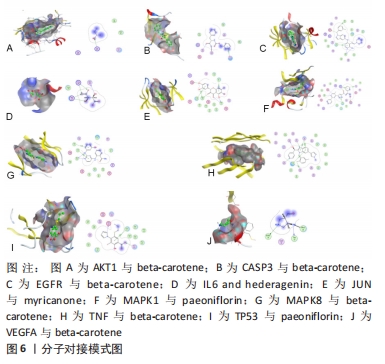
| [1] LI ZC, XIAO J, PENG JL, et al. Functional annotation of rheumatoid arthritis and osteoarthritis associated genes by integrative genome-wide gene expression profiling analysis. PLoS One. 2014;9:e85784. [2] SCOTT DL, WOLFE F, HUIZINGA TW. Rheumatoid arthritis. Lancet. 2010; 376:1094-108. [3] DE LANGE-BROKAAR BJ, IOAN-FACSINAY A, VAN OSCH GJ, et al. Synovial inflammation, immune cells and their cytokines in osteoarthritis: a review. Osteoarthritis Cartilage. 2012;20:1484-1499. [4] CHOY E. Understanding the dynamics: pathways involved in the pathogenesis of rheumatoid arthritis. Rheumatology (Oxford). 2012; 51(Suppl 5):v3-11. [5] JCH R, GARNERO P. Biological markers in osteoarthritis. Bone. 2012;51: 265-277. [6] BAECKLUND E, ILIADOU A, ASKLING J, et al. Association of chronic inflammation, not its treatment, with increased lymphoma risk in rheumatoid arthritis. Arthritis Rheum. 2006;54:692-701. [7] FRANKLIN J, LUNT M, BUNN D, et al. Incidence of lymphoma in a large primary care derived cohort of cases of inflammatory polyarthritis. Ann Rheum Dis. 2006;65:617-622. [8] DA MLM, DOS SNLL, DE CARVALHO JF. Autoantibodies and other serological markers in rheumatoid arthritis: predictors of disease activity. Clin Rheumatol. 2009;28:1127-1134. [9] 刘立,段金廒,宿树兰,等.用于妇科血瘀证痛经的四物汤类方——桃红四物汤的研究进展[J].中国中药杂志,2015,40(5):8. [10] 丁艳杰,张前德.桃红四物汤临床与实验研究进展[J].江苏中医药, 2010(1):77-79. [11] 马进,李振万,罗月中,等.基于网络药理学技术研究桃红四物汤延缓成纤维细胞生长的分子靶标[J].中国中药杂志,2020,45(17): 4120-4128. [12] 王升菊,刘倩倩,江华娟,等.基于网络药理学和分子对接技术探讨桃红四物汤治疗原发性痛经的有效成分及作用机制[J].中国中药杂志,2020,45(22):71-80. [13] KULASINGAM V, DIAMANDIS EP. Strategies for discovering novel cancer biomarkers through utilization of emerging technologies. Nat Clin Pract Oncol. 2008;5:588-599. [14] NANNINI M, PANTALEO MA, MALEDDU A, et al. Gene expression profiling in colorectal cancer using microarray technologies: results and perspectives. Cancer Treat Rev. 2009;35:201-209. [15] BUSTIN SA, DORUDI S. Gene expression profiling for molecular staging and prognosis prediction in colorectal cancer. Expert Rev Mol Diagn. 2004;4:599-607. [16] PAINE MF, SHEN DD, KUNZE KL, et al. First-pass metabolism of midazolam by the human intestine. Clin Pharmacol Ther. 1996;60(1): 14-24. [17] WALTERS WP, MURCKO MA. Prediction of’drug-likeness’. Adv Drug Deliv Rev. 2002;54(3):255-271. [18] HSIN KY, GHOSH S, KITANO H. Combining machine learning systems and multiple docking simulation packages to improve docking prediction reliability for network pharmacology.PLoS One. 2013;8:e83922. [19] 董开全.《金匮要略》中肾气丸之异病同治[J].国际中医中药杂志, 2011,33(7):638-639. [20] 于维汉,何耀华.槲皮素在治疗骨关节炎中作用机制的研究进展[J].中华骨与关节外科杂志,2019,12(6):477-480. [21] 裴凌鹏,董福慧,惠伯棣,等.Β,β-胡萝卜素改善H2O2对成骨细胞损伤的影响[J].西安交通大学学报(医学版),2007,28(1):78-82. [22] 蔡纪平.五味子醇甲对大鼠成骨细胞增殖与分化的影响及其作用的信号通路研究[D].石家庄:河北医科大学,2018. [23] PENG XD, XU PZ, CHEN ML, et al. Dwarfism, impaired skin development, skeletal muscle atrophy, delayed bone development, and impeded adipogenesis in mice lacking Akt1 and Akt2. Genes Dev. 2003;17: 1352-1365. [24] 杨远超,王颖,方志远,等. 抗炎产生抗骨质疏松作用的植物[J].中国组织工程研究,2018,22(4):638-643. [25] ZHANG J, FU Q, REN Z, et al. Changes of serum cytokines-related Th1/Th2/Th17 concentration in patients with postmenopausal osteoporosis. Gynecol Endocrinol. 2015;31(3):183-190. [26] 冯馨锐,崔雨舒,何志涛,等肿瘤坏死因子-α的生物学功能研究进展[J].吉林医药学院学报,2019,40(1):66-68. [27] ZHA L, HE L, LIANG Y, et al. TNF-αcontributes to postmenopausal osteoporosis by synergistically promoting RANKL-induced osteoclast formation. Biomed Pharmacother. 2018;102:369-374. [28] 欧国峰,刘鑫,董博,等.绝经后骨质疏松症的免疫学研究进展[J].中医正骨,2016,28(8):70-72. [29] MURAD R, SHEZAD Z, AHMED S, et al. Serum tumour necrosis factor alpha in osteopenic and osteoporotic postmenopausal females:A cross-sectional study in Pakistan. J Pak Med Assoc. 2018;68(3):428-431. [30] 梁伟燊,刘逸雷,李紫元,等.板连败毒口服液解热作用及其机理研究[J].动物医学进展,2019,40(2):74-78. [31] RYOO S, LEE S, JO S, et al. Effect of lipopolysaccharide (LPS) on mouse model of steroid-induced avascular necrosis in the femoral head (ANFH). J Microbiol Biotechnol. 2014;24(3):394-400. [32] 朱道宇,杨前昊,高悠水,等.TLR4通路与激素性股骨头坏死关系的研究进展[J].中国骨与关节杂志,2019,8(1):75-79. [33] TIAN L, WEN Q, DANG X, et al. Immune response associated with Toll-like receptor 4 signaling pathway leads to steroid-induced femoral head osteonecrosis. BMC Musculoskelet Disord. 2014;15:18. [34] 邹玉婷,沈建国.AGEs/AGE-RAGE与糖尿病血管并发症[J].浙江医学, 2008,30(3):298-300. [35] 李悦鹏.甜瓜MAPK级联途径基因家族的鉴定及CmMPKs功能分析[D].沈阳:沈阳农业大学,2020. [36] 郑启德,林海青.益气生津活血颗粒对糖尿病大鼠心肌细胞IL-1,ET,NF-κB,TNF-α,VEGF含量的影响[J].药学研究,2018,37(7):381-383. [37] KIM I, MOON SO, KIM SH, et al. Vascular Endothelial Growth Factor Expression of Intercellular Adhesion Molecule 1 (ICAM-1), Vascular Cell Adhesion Molecule 1 (VCAM-1), and E-selectin through Nuclear Factor-κB Activation in Endothelial Cells. J Biol Chem. 2001;276(10):7614-7620. [38] ZHANG F, HUANG X, QI Y, et al. Juglanin Inhibits Osteoclastogenesis in Ovariectomized Mice via the Suppression of NF-κB Signaling Pathways. Front Pharmacol. 2021;11:596230. [39] 姜璐,王伟芹,路士华,等.银杏内酯A对LPS诱发肝细胞损伤的保护作用及机制[J].山东医药,2017,57(9):28-30. [40] SMITS PJ, KONCZYK DJ, SUDDUTH CL, et al. Endothelial MAP2K1 mutations in arteriovenous malformation activate the RAS/MAPK pathway. Biochem Biophys Res Commun. 2020;529(2):450-454. [41] 唐晓琳. miR-3182调控LPPR4表达并抑制成骨细胞分化成熟的研究[J].中华老年骨科与康复电子杂志,2021,7(3):5. [42] 陈晓婷,姜天缘,夏超,等.骨化三醇通过PI3K/AKT促进BMP9诱导的间充质干细胞成骨分化作用[J].医用生物力学,2019,34(2): 200-206. [43] 冉庆林,林浩,李东,等.胸腰椎压缩性骨折老年患者肺部感染对TLR7/IL-23/IL-17信号通路的影响[J].临床和实验医学杂志,2018, 17(7):733-737. |
| [1] | Jin Tao, Liu Lin, Zhu Xiaoyan, Shi Yucong, Niu Jianxiong, Zhang Tongtong, Wu Shujin, Yang Qingshan. Osteoarthritis and mitochondrial abnormalities [J]. Chinese Journal of Tissue Engineering Research, 2022, 26(9): 1452-1458. |
| [2] | Zhang Lichuang, Xu Hao, Ma Yinghui, Xiong Mengting, Han Haihui, Bao Jiamin, Zhai Weitao, Liang Qianqian. Mechanism and prospects of regulating lymphatic reflux function in the treatment of rheumatoid arthritis [J]. Chinese Journal of Tissue Engineering Research, 2022, 26(9): 1459-1466. |
| [3] | Zhang Jichao, Dong Yuefu, Mou Zhifang, Zhang Zhen, Li Bingyan, Xu Xiangjun, Li Jiayi, Ren Meng, Dong Wanpeng. Finite element analysis of biomechanical changes in the osteoarthritis knee joint in different gait flexion angles [J]. Chinese Journal of Tissue Engineering Research, 2022, 26(9): 1357-1361. |
| [4] | Wang Baojuan, Zheng Shuguang, Zhang Qi, Li Tianyang. Miao medicine fumigation can delay extracellular matrix destruction in a rabbit model of knee osteoarthritis [J]. Chinese Journal of Tissue Engineering Research, 2022, 26(8): 1180-1186. |
| [5] | Liu Dongcheng, Zhao Jijun, Zhou Zihong, Wu Zhaofeng, Yu Yinghao, Chen Yuhao, Feng Dehong. Comparison of different reference methods for force line correction in open wedge high tibial osteotomy [J]. Chinese Journal of Tissue Engineering Research, 2022, 26(6): 827-831. |
| [6] | Zhou Jianguo, Liu Shiwei, Yuan Changhong, Bi Shengrong, Yang Guoping, Hu Weiquan, Liu Hui, Qian Rui. Total knee arthroplasty with posterior cruciate ligament retaining prosthesis in the treatment of knee osteoarthritis with knee valgus deformity [J]. Chinese Journal of Tissue Engineering Research, 2022, 26(6): 892-897. |
| [7] | Zhao Yuwei, Gao Yuting, Li Zhen, Hao Huiqin . Mechanism of Ermiao San in the treatment of rheumatoid arthritis [J]. Chinese Journal of Tissue Engineering Research, 2022, 26(5): 742-748. |
| [8] | Xu Lei, Han Xiaoqiang, Zhang Jintao, Sun Haibiao. Hyaluronic acid around articular chondrocytes: production, transformation and function characteristics [J]. Chinese Journal of Tissue Engineering Research, 2022, 26(5): 768-773. |
| [9] | He Junjun, Huang Zeling, Hong Zhenqiang. Interventional effect of Yanghe Decoction on synovial inflammation in a rabbit model of early knee osteoarthritis [J]. Chinese Journal of Tissue Engineering Research, 2022, 26(5): 694-699. |
| [10] | Lin Xuchen, Zhu Hainian, Wang Zengshun, Qi Tengmin, Liu Limin, Suonan Angxiu. Effect of xanthohumol on inflammatory factors and articular cartilage in a mouse mode of osteoarthritis [J]. Chinese Journal of Tissue Engineering Research, 2022, 26(5): 676-681. |
| [11] | Liu Jin, Li Zhen, Hao Huiqin, Wang Ze, Zhao Caihong, Lu Wenjing. Ermiao san aqueous extract regulates proliferation, migration, and inflammatory factor expression of fibroblast-like synovial cells in collagen-induced arthritis rats [J]. Chinese Journal of Tissue Engineering Research, 2022, 26(5): 688-693. |
| [12] | Zhang Tong, Cai Jinchi, Yuan Zhifa, Zhao Haiyan, Han Xingwen, Wang Wenji. Hyaluronic acid-based composite hydrogel in cartilage injury caused by osteoarthritis: application and mechanism [J]. Chinese Journal of Tissue Engineering Research, 2022, 26(4): 617-625. |
| [13] | Zhang Jian, Lin Jianping, Zhou Gang, Fang Yehan, Wang Benchao, Wu Yongchang. Semi-quantitative MRI evaluation of cartilage degeneration in early knee osteoarthritis [J]. Chinese Journal of Tissue Engineering Research, 2022, 26(3): 425-429. |
| [14] | Wang Chong, Zhang Meiying, Zhou Jian, Lao Kecheng. Early gait changes after total hip arthroplasty through direct anterior approach and posterolateral approach [J]. Chinese Journal of Tissue Engineering Research, 2022, 26(3): 359-364. |
| [15] | Liu Shaohua, Zhou Guanming, Chen Xicong, Xiao Keming, Cai Jian, Liu Xiaofang. Changes in kinematic parameters after unicompartmental knee arthroplasty and high tibial osteotomy [J]. Chinese Journal of Tissue Engineering Research, 2022, 26(3): 390-396. |
| Viewed | ||||||
|
Full text |
|
|||||
|
Abstract |
|
|||||
